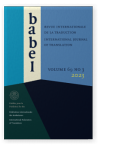Vol. 69:3 (2023) ► pp.305–332
Do education and the labor market speak the same language?
Challenges of the ESCO European classification of occupations in mapping today’s professional translators
This paper addresses the need for terminology convergence and the systematic use of up-to-date descriptors and concepts in the European higher education and labor market environments. Rapid developments in the language industry are remodelling the translation profession in particular and generating new processes, new training needs and, therefore, a new skills demand. Changing market expectations, cross-occupational mobility and multifaceted professional profiles in the translation industry claim to exploit the full potential of standard and multilingual taxonomies like ESCO – the European Classification of Skills, Competences, Qualifications and Occupations. This research draws on the European Master’s in Translation (EMT) competence framework for 2018–2024 to perform a descriptive analysis of the English and Spanish entries for the occupation of “translator” in ESCO’s latest 2020 version. Findings suggest that ESCO’s content could be aligned with the professionally oriented EMT framework to overcome shortcomings in representing translators’ identity and present the reality of the translation market, while matching its content more accurately to the most relevant skills and competences generally developed in current translator training programs.
Article outline
- 1.Introduction
- 2.Employability and competences in the European Higher Education Area (EHEA)
- 3.An approach to employability in Translation Studies
- 4.European Master’s in Translation (EMT) competence framework
- 5.Towards a common language: ESCO classification
- 5.1Methodology for the analysis of the “translator” occupation
- 6.Analysis of results in ESCO
- 6.1Description of the “translator” profession
- 6.2Alternative labels
- 6.3Position in the hierarchical structure for “translator”
- 6.4Narrower occupations
- 6.5Essential skills, competences, and knowledge
- 6.6Optional skills, competences and knowledge
- 7.Conclusions and further discussion
- Notes
-
References
